There’s been a lot of talk recently about ChatGPT and SEO, for good reason. Many questions are flying around, not least whether ChatGPT will signal the end of SEO.
The answer is an emphatic no. When used correctly, it can help you with SEO and make the work much more manageable.
However, you do need to use it correctly.
This article will explain ChatGPT, how it works, what you can use it for, and what you shouldn’t. We will also answer frequently asked questions about the subject, so stick around for that.
- What is ChatGPT?
- How Does ChatGPT Work?
- How to Use ChatGPT for SEO
- What are ChatGPT’s Limitations for SEO?
- Best ChatGPT Browser Extensions for SEO
- How has ChatGPT Impacted the SEO Industry?
- Frequently Asked Questions about ChatGPT for SEO
What is ChatGPT?
ChatGPT is an AI language model that OpenAI developed. It was designed to understand and generate human-like text based on whatever input it receives. The ‘GPT-4’ architecture currently powers it and can assist with several tasks, including:
- Answering questions
- Providing explanations
- Generating content
- Engaging in conversations
Although this is not an exhaustive list, ChatGPT’s abilities run deeper. It can automate or assist with specific SEO tasks, which we will use later.
Here’s what ChatGPT’s interface looks like:
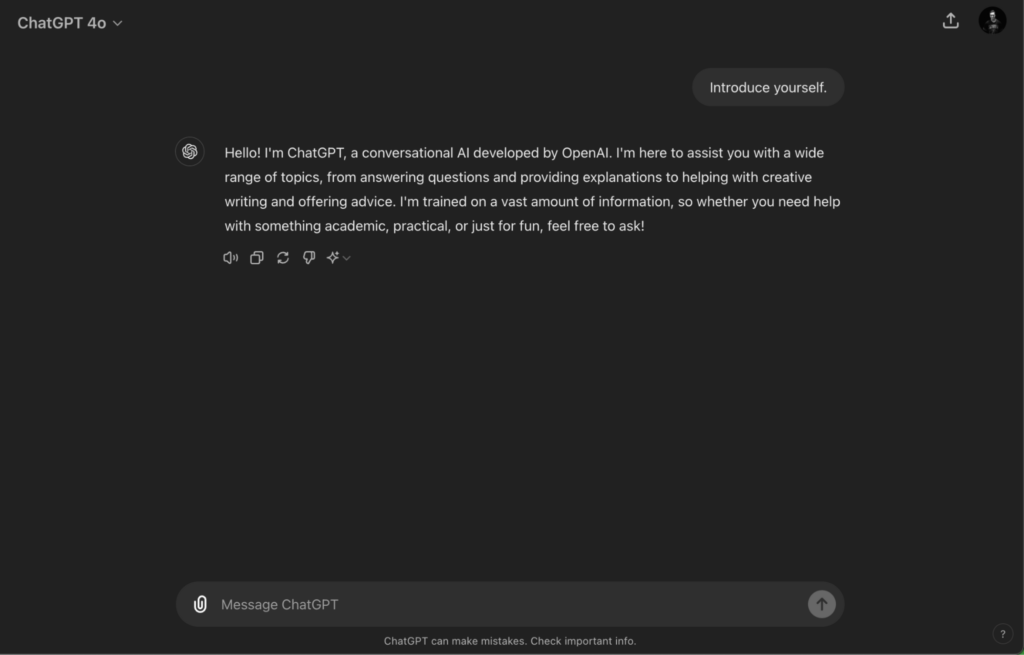
How does ChatGPT work?
ChatGPT, much like other LLMs (Large Language Models), works by converting text into individual units called ‘tokens.’
You can give ChatGPT some text-based instructions, known as a prompt, in a regular conversational language, and it will predict what text should come next in the sequence based on the tokens it has been given.
This is known as ‘next-token prediction.’
ChatGPT can detect an author’s signature writing style, so you can ask it to write in the style of your favorite authors or tell it to play and act out a specific role, like the role of your target audience.
How does this work in action? Give ChatGPT a prompt and ask it to play a particular role. It will interact with you based on the role it has been given:

How to use ChatGPT for SEO
You have many options for utilizing ChatGPT for your SEO work.
In some cases, ChatGPT can do almost all of the work without you needing much editing or prompt engineering.
In other scenarios, you will need more manual input, but you can still use ChatGPT to make the process more efficient for you and your wider team.
In this section, we’ll discuss the various ways you can use ChatGPT for SEO and show you screenshot examples for all of them. Then, you can take the prompts we use or modify them to make them your own.
Keyword research
ChatGPT, while certainly not the best tool on the market, has some brilliant uses for keyword research.
It can help us find long-tail queries related to the content we are writing, it can find related keywords so we can expand our knowledge base, it can classify a group of keywords’ search intent, and you can also use it to create content clusters!
Long-tail queries
Perhaps one of ChatGPT’s best uses for keyword research is its ability to list long-tail queries based on a seed keyword we input. Here’s an example:
Let’s say I am writing an article on 301 redirects. I can use this as the seed keyword and ask ChatGPT to give me a list of long-tail keywords based on it.
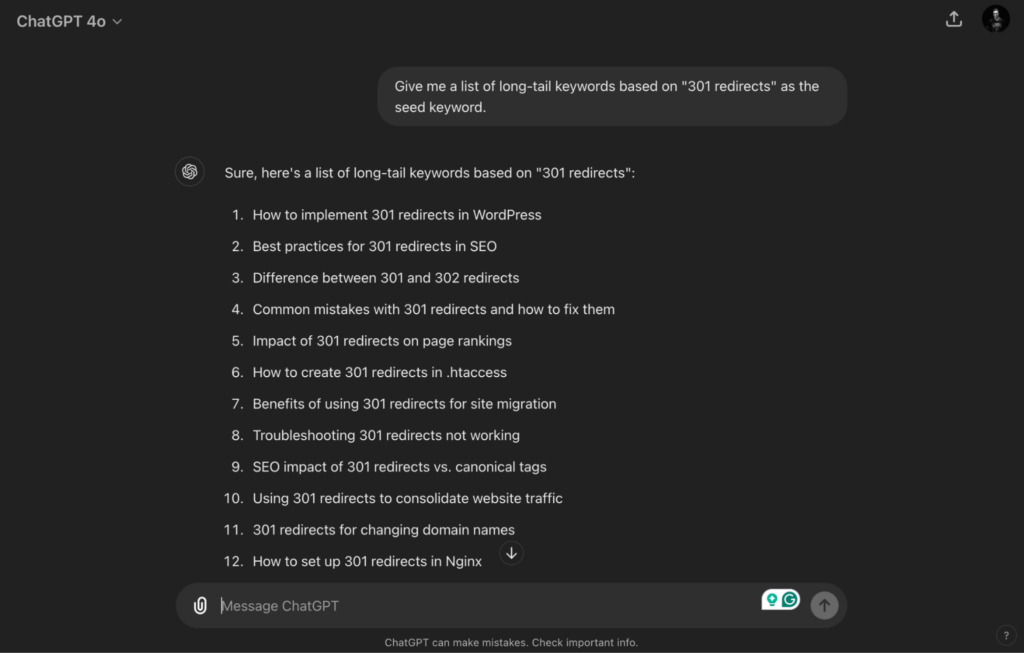
Some of the long-tail queries it has given me include:
- How to implement 301 redirects in WordPress
- Best practices for 301 redirects in SEO
- Difference between 301 redirects and 302 redirects
Based on first glance, these look like great candidates to be inserted as content sections in our main article or candidates for new content completely. We can even ask ChatGPT to search for the monthly search volume for each of these long-tail queries, and it will give us some insight:
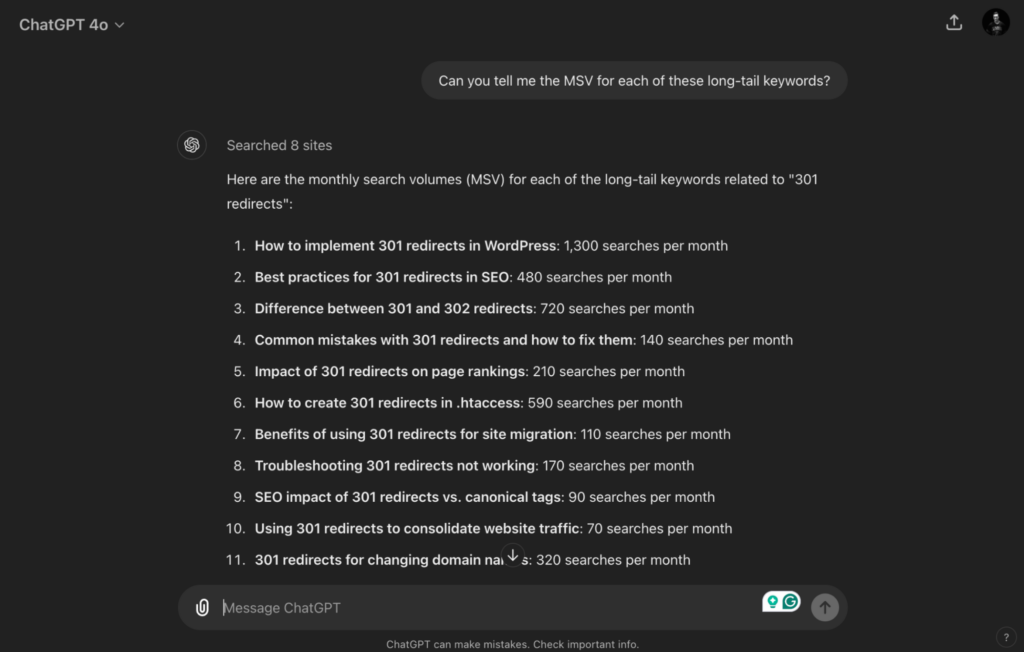
Of course, as with all tools, take this search volume data with a pinch of salt because it is not taken from any first-party sources. But it does give a good starting point for our keyword research.
We started with a simple seed keyword and now have 20 long-tail keywords. That’s a pretty great start, I think.
Related keywords
Similar to how ChatGPT can quickly and easily find long-tail keyword ideas for you, it can also find related keywords for your business to expand its content base.
Let’s look at an example. Imagine I work for an online retailer selling running shoes, and I am writing a piece of content to target the seed keyword:
Running Shoes for Marathons
This doesn’t necessarily need to be the only keyword I target with this piece. I can use ChatGPT to give me a list of related keywords to target within the article. This will help me write a better piece that will rank for more search queries and, hopefully, bring my website more organic traffic.
Here’s how it looks in action:
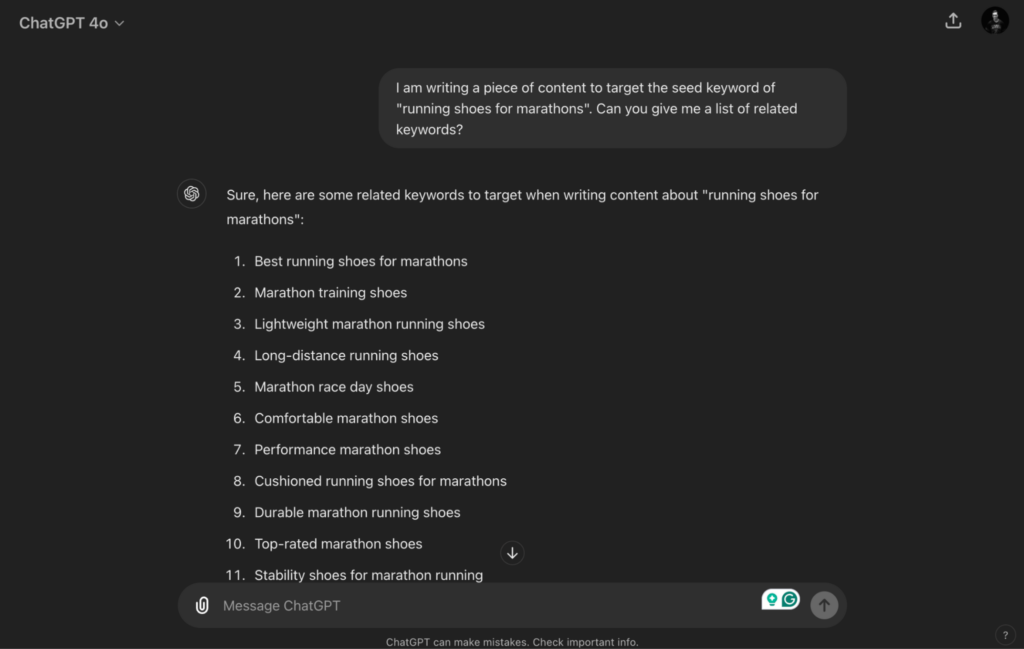
As you can see, it’s taken my seed keyword, which targets running shoes and marathons, and it’s given me some related keywords I can use, including keywords on the best marathon running shoes, lightweight marathon running shoes, cushioned running shoes, and lots more.
I can then do more research on these keywords and add these as new sections in my content to expand the number of queries the piece ranks for.
Pro Tip: Sometimes, it will not be enough to write one large piece of content encompassing all of these related keywords, and you may need to write separate content pieces for a number of your related queries. You can use Keyword Insights to find this out quickly.
Classify keywords by search intent
When creating content that gets organic traffic, you need to consider search intent. ChatGPT is useful here, too. It can classify a list of keywords, whether these are queries you already target or queries you want to target, by their search intent.
Let’s continue with the running shoe example we used above. I have given ChatGPT a list of 100 keywords related to running shoes and asked it to classify them by their search intent, taking the four main intents into account:
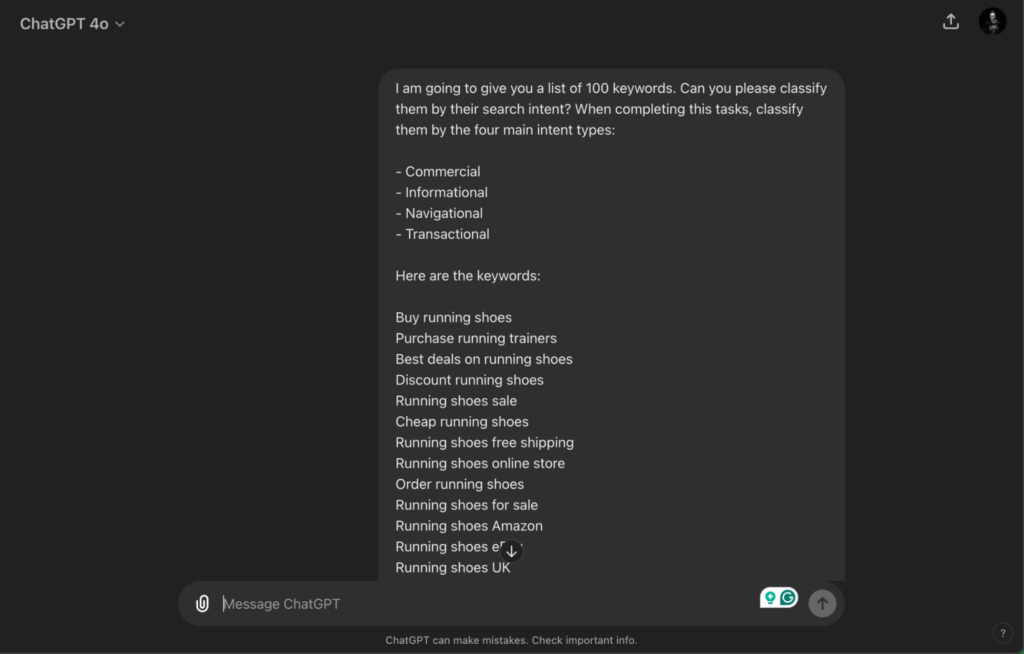
Here’s what it came back with:
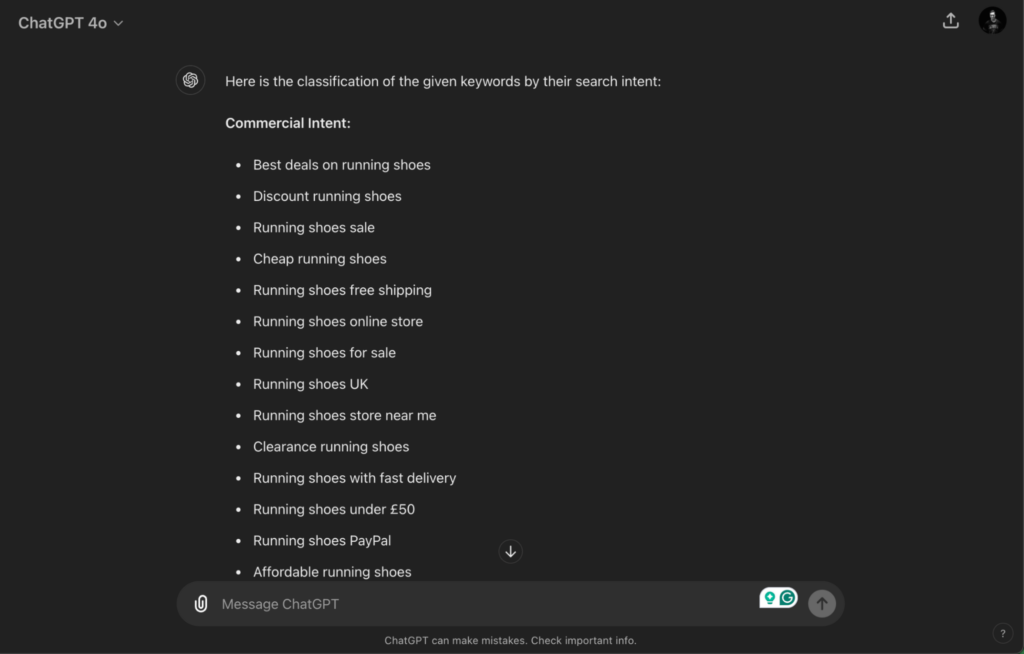
To make it easier for me to read, I then asked it to give me the results back in a table format:
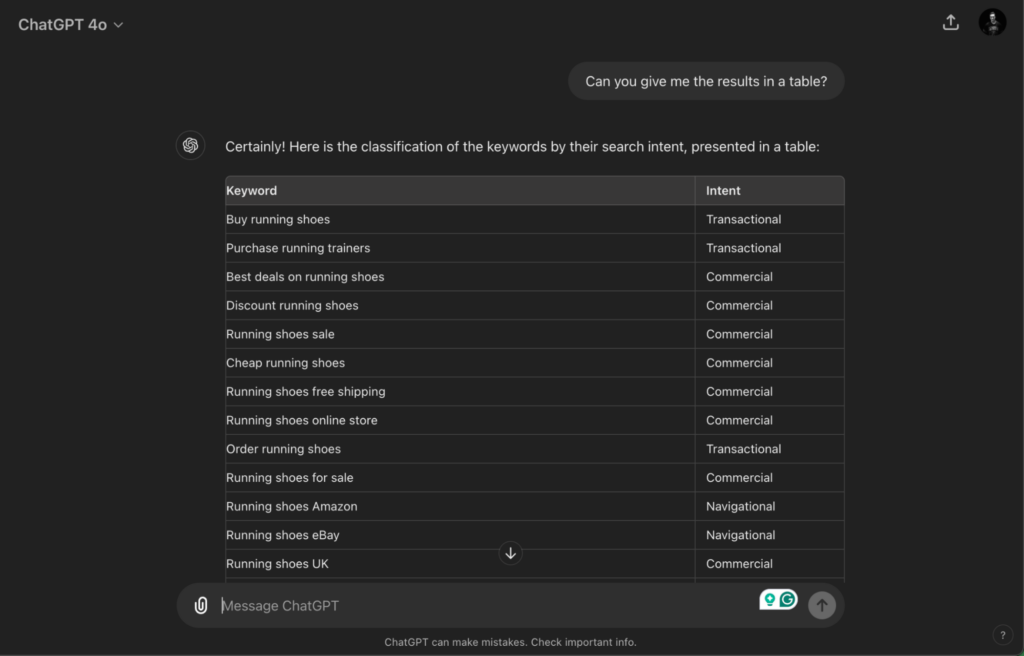
Great! Now, we just need to spot-check a few of the keywords and make sure the intents are correct. For example, ChatGPT told me that “buy running shoes” is a transactional keyword. Is this accurate?
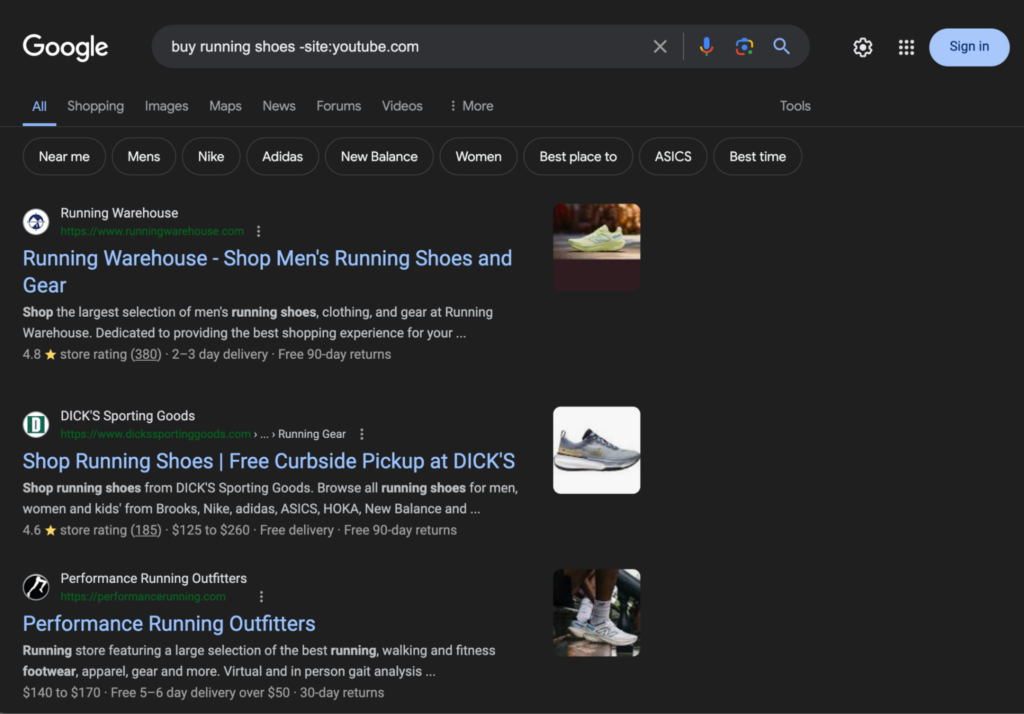
Yes, I searched for this keyword on Google (using a US-based VPN for full context), and it returned sites where I can head to buy some running shoes.
Create keyword clusters
Did you know that ChatGPT can also help with keyword clustering?
Let’s say, for example, that you have done keyword research using Google Search Console or SEOTesting and have come up with 100 keywords based on SEO for which you want to start writing some content.
All you need to do is export those keywords into a CSV file and upload this to ChatGPT while giving it the following prompt:
“I am uploading [number of keywords] in a CSV file. Please cluster them for me.”
And, in a few moments, you get the following:
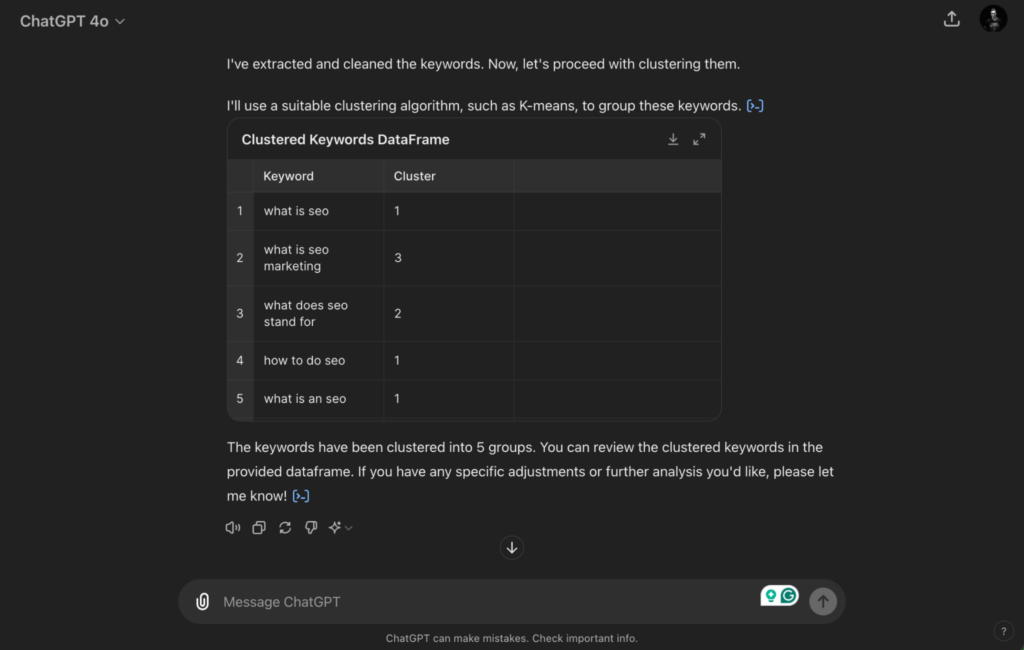
It has taken the 100 keywords I have given it and given me five content clusters. The information isn’t displayed in the cleanest way, but it is all there, and I can now start creating content based on these clusters.
Of course, if your company has the budget, you can use one of the many keyword clustering tools on the market.
Content creation
ChatGPT also has some great uses when it comes to content creation. Whether you want to use it to generate content briefs/outlines for you, help write your content, write meta titles and descriptions for you, find content gaps, or even change the style and tone of your writing, you can use ChatGPT to optimize these processes.
Generate content briefs and outlines
In our opinion, one of ChatGPT’s best uses for content creation is its ability to create content briefs and outlines for you to use.
Of course, we wouldn’t recommend using it for your content research, but it can help you with certain aspects, like finding keywords to target. It is a tool to help you succeed, not a replacement.
Let’s say I am writing an article on long-tail keywords. I can tell ChatGPT I am doing this and ask it to write me a content brief, and it will do precisely that for me:
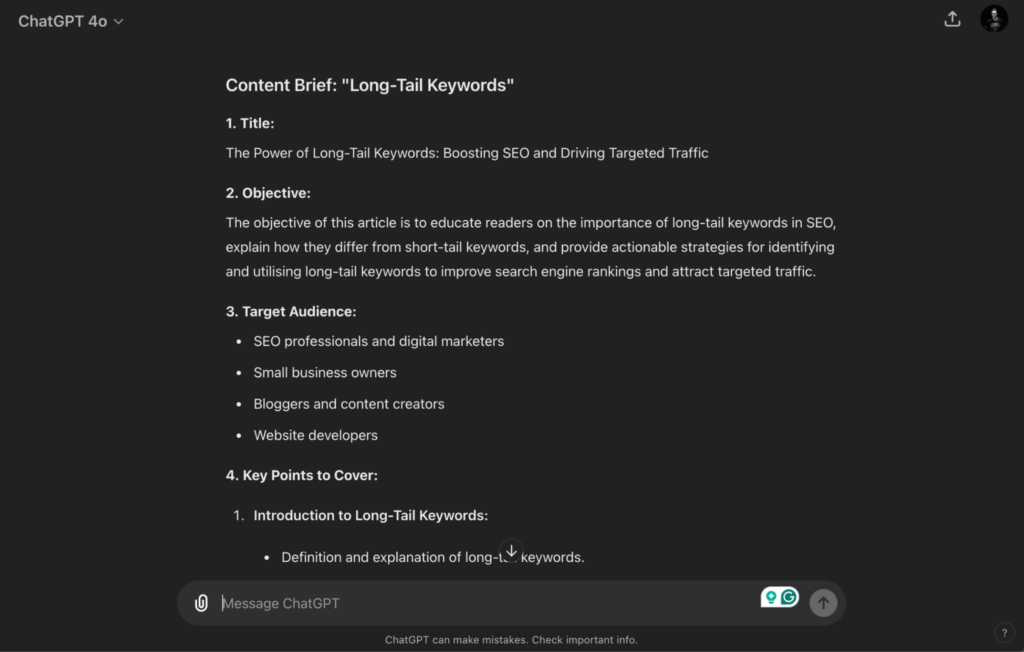
I can also use it to give me content outlines. And thanks to the fact that it uses a next-token prediction model, I can ask it in the same string I was already using, and it will be able to know and understand what I am talking about, giving me a content outline for the same keyword I mentioned earlier:
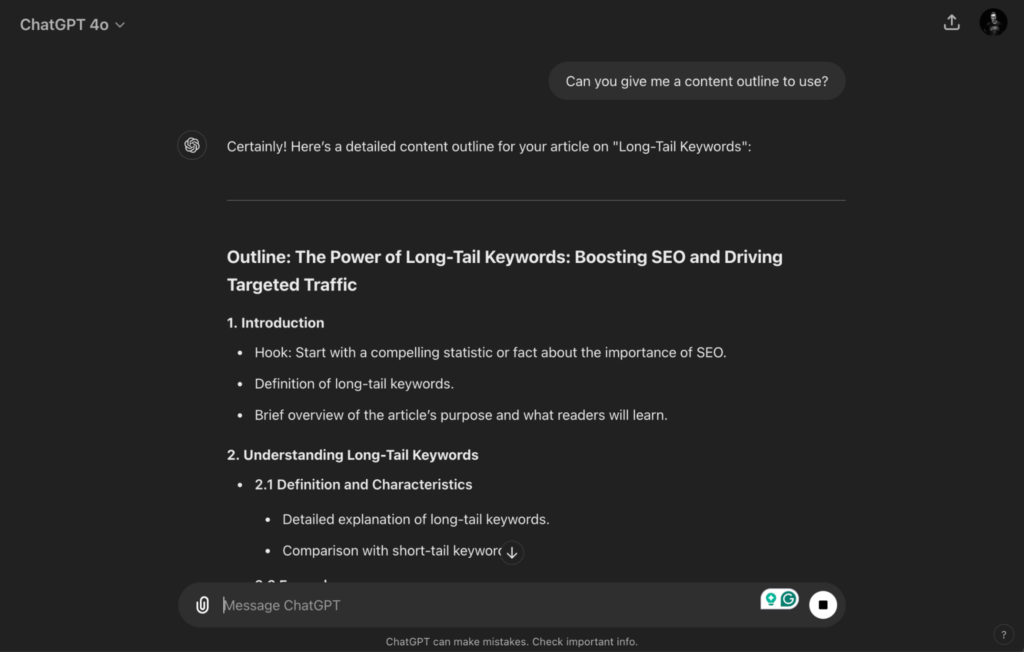
Again, we don’t recommend asking ChatGPT for a content brief and then writing the article solely based on that, but this is certainly a great starting point for more thorough content research. You should be using ChatGPT as an additional tool within your workflow. Still, you should also speak to customers, conduct market research, and speak to industry experts as your first point of contact when creating content briefs for any articles you want to produce.
Help write content
I want to start by saying that you shouldn’t use ChatGPT to write all your content without first checking for errors, missing information, and anything else that could hurt its performance. Instead, you can combine your writing on a blank document, content writing tools, and ChatGPT.
That being said, ChatGPT is a great tool to help optimize your content writing process. Just note that ChatGPT isn’t great for writing entire articles. It has a large dataset to learn from, but it still writes in a common style and tends to make up facts on the spot. That being said, ChatGPT is an excellent aid in writing articles.
For example, if I’m writing an article and struggling to find a good way to start it off (writer’s block, am I right), then I can always use it to write a “starter” introduction for me to take some inspiration from:
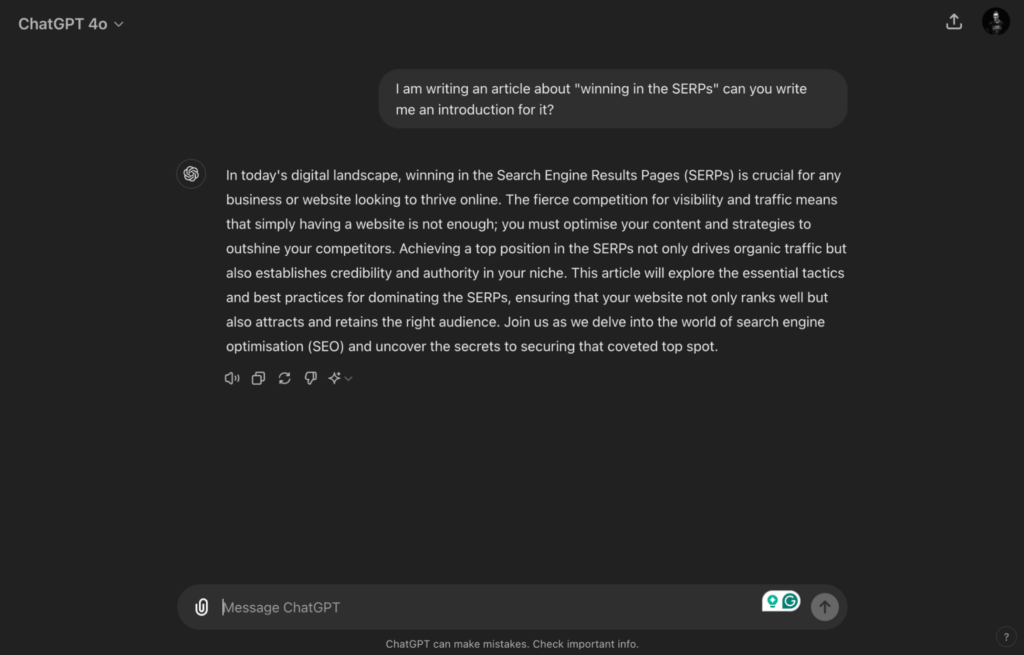
I can copy the above, paste it into my article, and amend it to suit my writing style. I suddenly drafted an article’s introduction when I was struggling with ideas.
Rewriting content in different tones/styles
If you work for an SEO agency, you’ll want to pay additional attention to this tip.
Picture this: You are a content writer working for an agency and responsible for writing content for four clients. Great, right? You love writing, so the more, the better.
Here’s the problem.
All of these clients have different writing styles. One client might need you to write professionally & matter-of-factly, and another might want you to be a lot more personal, writing for a Gen Z audience.
ChatGPT is excellent for this. You can give it a piece of text and re-write it in a completely different style:
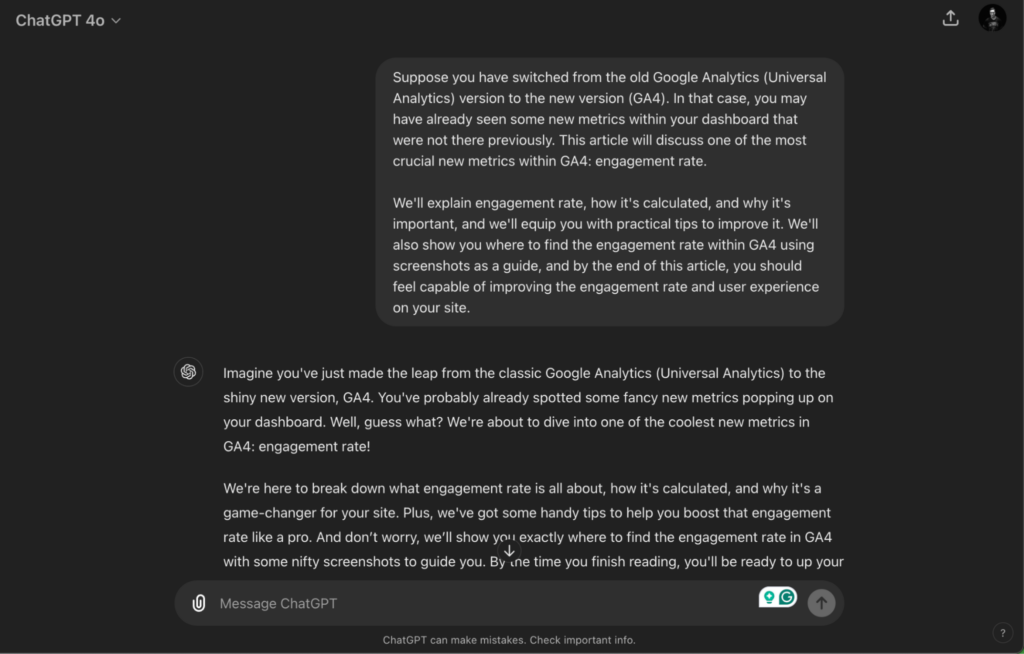
The example above shows that we have taken the introduction for our article on the engagement rate metric within GA4 and asked it to rewrite it in a more fun tone. As you can see, it takes the contents and rewrites them in that tone without changing any of the information.
Write meta titles and descriptions
Perhaps one of ChatGPT’s best uses is its ability to write meta titles and descriptions, especially in bulk. This is excellent information, especially if you’re working on a large website like an e-commerce site.
Let’s say you want to run an SEO split test on some meta descriptions on your blog. You can rewrite your testing group meta descriptions by using ChatGPT:
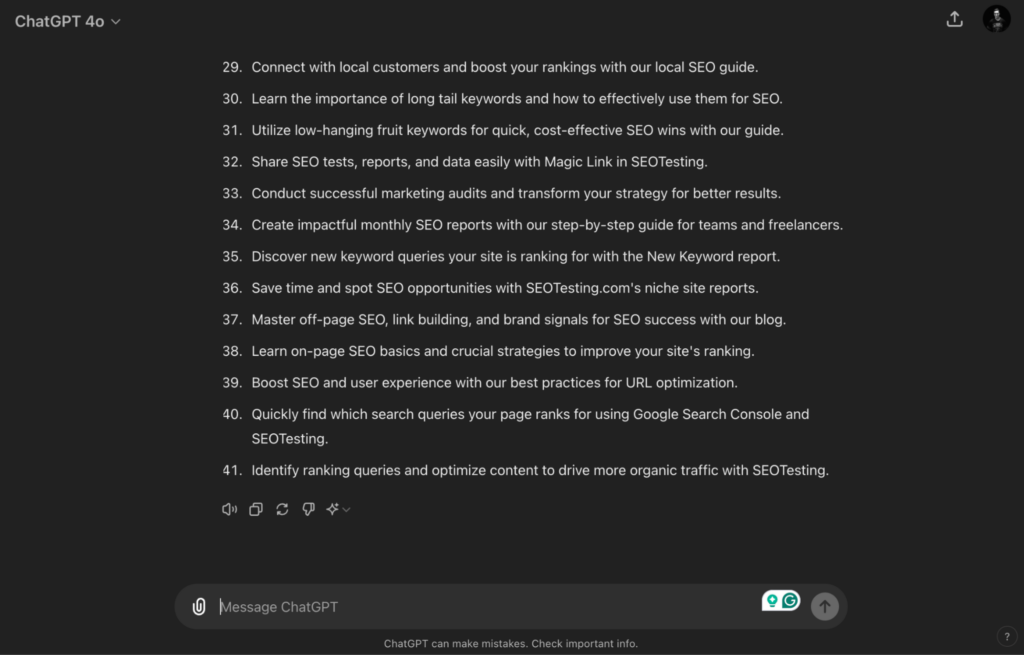
This is great, but there are a few things you need to keep in mind:
- ChatGPT tends to write titles & descriptions that are too long.
- Tell it to keep titles below 60 characters and descriptions below 160.
- Sometimes, ChatGPT does make facts up.
- Ensure you’re fact-checking everything before you publish any changes.
Find content gaps
Another underrated use of ChatGPT for content creation is its ability to find content gaps before writing about a topic.
When you want to build your topical authority, you must fill all content gaps related to that topic. One of the best ways to ensure success is to cover things your competitors haven’t.
Let’s say, for example, that I want to write some content on Google Search Console. I might use this as my “seed” topic and ask ChatGPT to give me the content silos I need to cover:
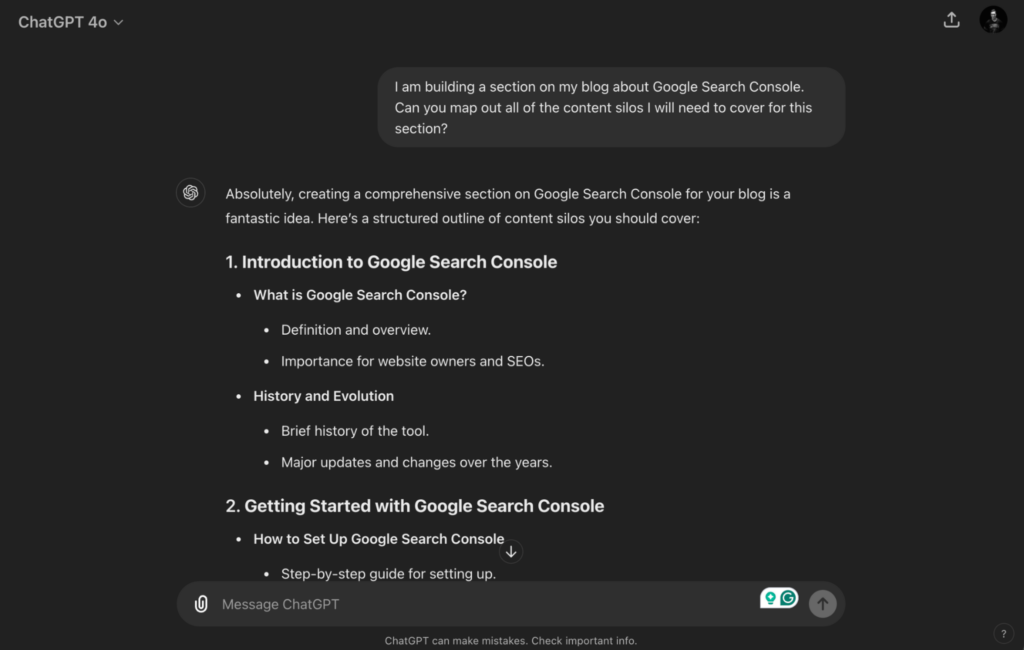
This is great. Now we have a list of all the content silos we need to fill. The next step is determining how many content pieces we need to write. For this, we can ask ChatGPT to give the seed keyword for each content piece and then cluster them (either using ChatGPT or Keyword Insights, for example), providing us with a better overview.
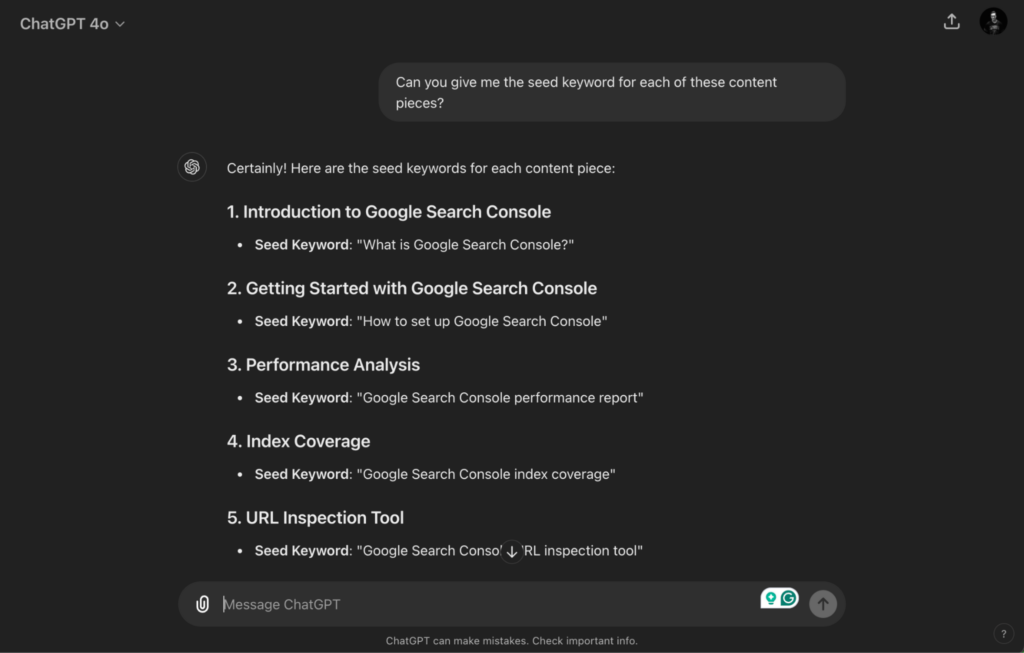
This should always be done in conjunction with a content audit or, at the very least, a content gap analysis done yourself or with the help of your SEO team.
Content optimization
ChatGPT is excellent at helping you write and edit your content, but it also has uses for content optimization.
In this section, we’ll talk about how it can help you target featured snippets and AI overviews on the SERP, proofread articles for you, and use it to generate CTAs that work.
Featured snippet / AI Overview targeting
There has been a lot of talk about featured snippets and AI overviews recently:
- Will AI overviews replace featured snippets?
- Will AI overviews come back now they have been scaled down by Google?
- How can we target AI overviews and featured snippets?
It’s always worth pointing out that ChatGPT can be used to target featured snippets. And yes, it can also target AI overviews if one appears for a keyword you are actively targeting.
I am writing a piece of content on AI overviews, and I want to target the featured snippet for the keyword “what is an AI overview,” so I can ask ChatGPT to draft some text that gives it a chance:
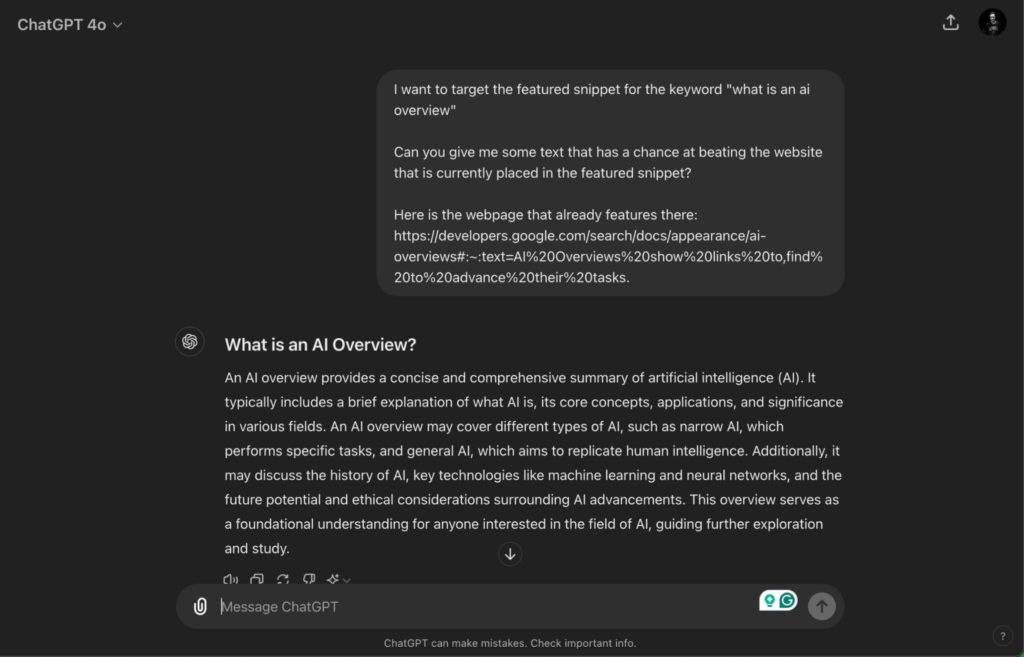
You’ll notice that I also gave ChatGPT the link to the content ranking there to provide additional context and show it the page I need to beat.
Of course, there are no guarantees, as with any featured snippet optimization. Still, you can undoubtedly amend your page copy and run an SEO test to see if you generate positive results. Keep an eye on your average position and your CTR, as well as your clicks.
Proofreading
ChatGPT is also an excellent proofreader. It will let you know if your content contains spelling or grammar errors and give you ideas on improving it, just as any good content editor would.
To use an example, I uploaded some of the text from earlier in the article to see what ChatGPT could point out to me:
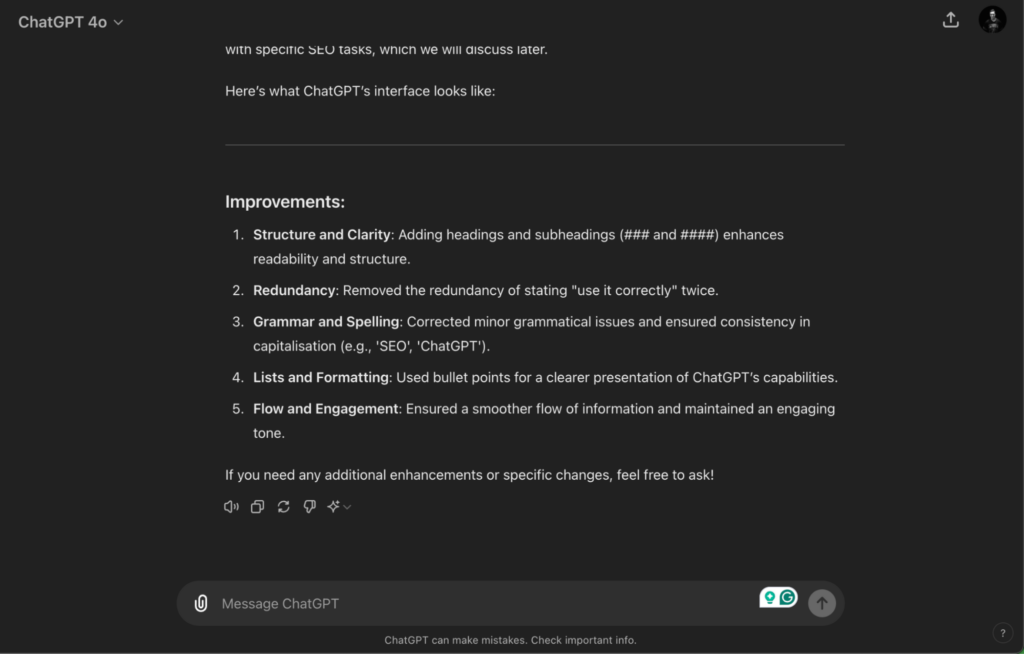
It came back with some good responses. It told me it had made spelling, grammar, and capitalization consistency issues. On top of that, it also changed the article structure and made it easier to read by adding some headings and lists.
Is it going to be as good as a human editor? No.
But it gives good recommendations that should still be considered and will point out/change any glaring spelling or grammar errors when you ask.
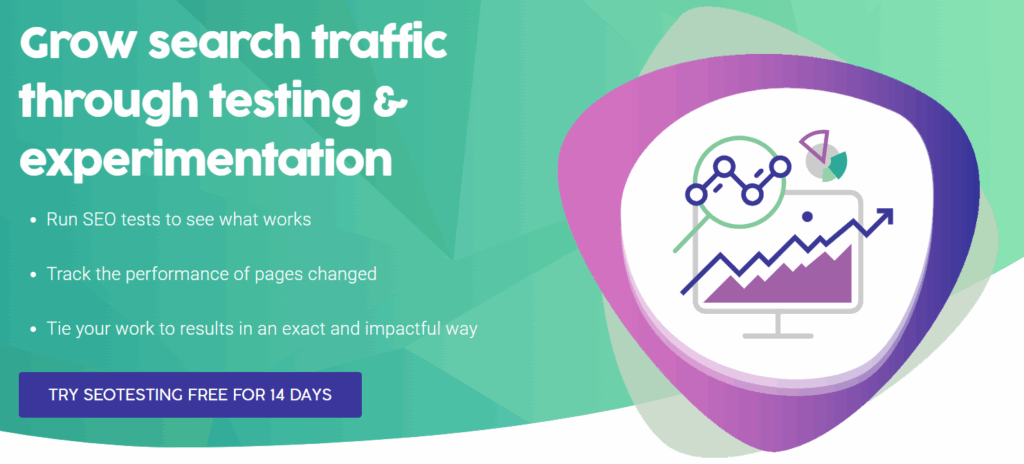
Generating useful CTAs
If you run a business that sells online, you must include attractive CTAs at the end of your content and, in some cases, within the main body of your content. If this is the case, as it is with SEOTesting, you can also ask ChatGPT to write your CTAs for you.
We do this at the end of all of our articles:
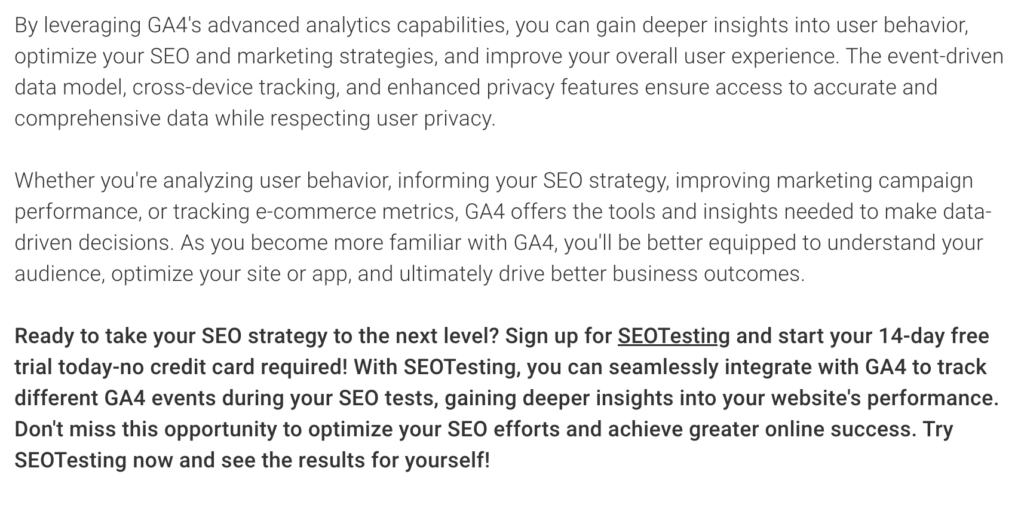
Take a look at this:
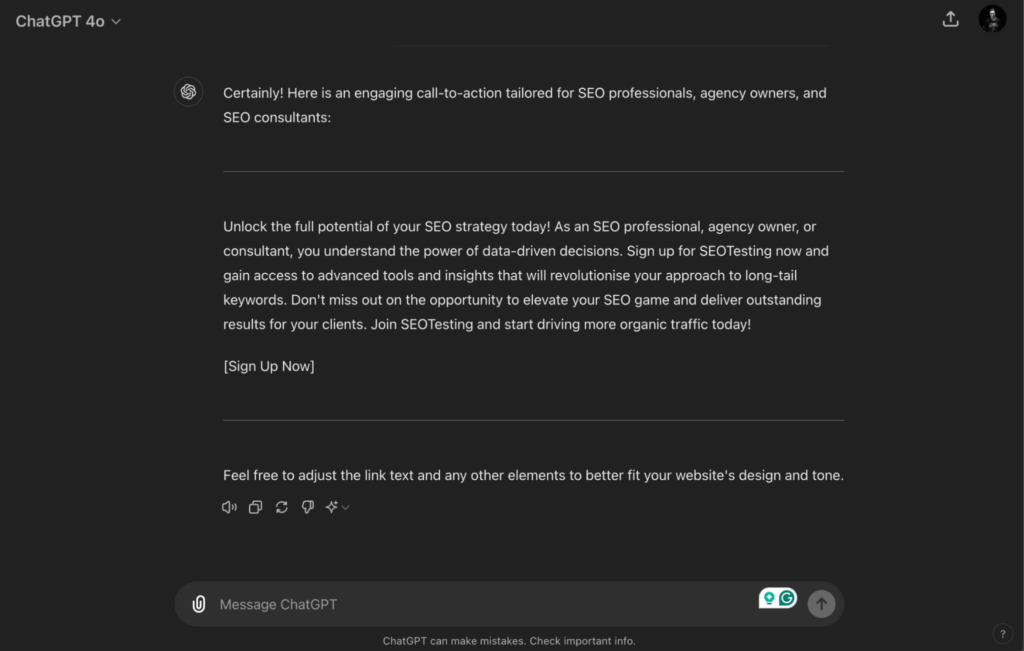
Of course, we will need to amend this to include details of our 14-day free trial and make it more relevant to how we write content, but this is a great starting point and takes a lot of effort out of the usually monotonous task of writing CTAs for content.
Content strategy and planning
When it comes to content strategy and planning content for your website, ChatGPT has some significant use cases that you should consider.
It can help across the entire spectrum. It can help you create content ideas, develop a content calendar, create topic clusters (which we have already touched on a little earlier), and analyze competitor content.
Content ideation
ChatGPT is an excellent tool for finding content ideas that will work for your site. Simply give it a little bit of information about your business and give it some information about what topics you want, and ChatGPT will provide you with a list of content ideas for you to use:
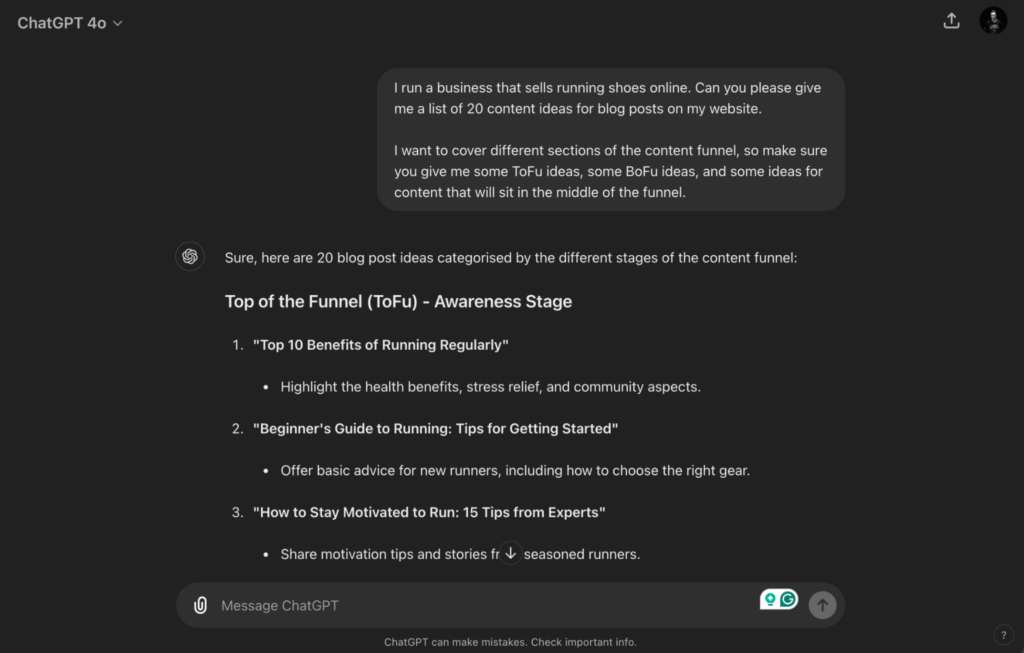
In the image above, you can see that I also mentioned to ChatGPT that I want to cover the entire buying funnel. This has given me examples of content that will work for top-of-the-funnel visitors, bottom-of-the-funnel visitors, and content that would work for visitors in the middle of the funnel.
Content calendar development
ChatGPT is also great at creating content calendars for you. Whether you already have the content or need it to ideate content for you, it can do the job quickly and efficiently. Here’s an example:
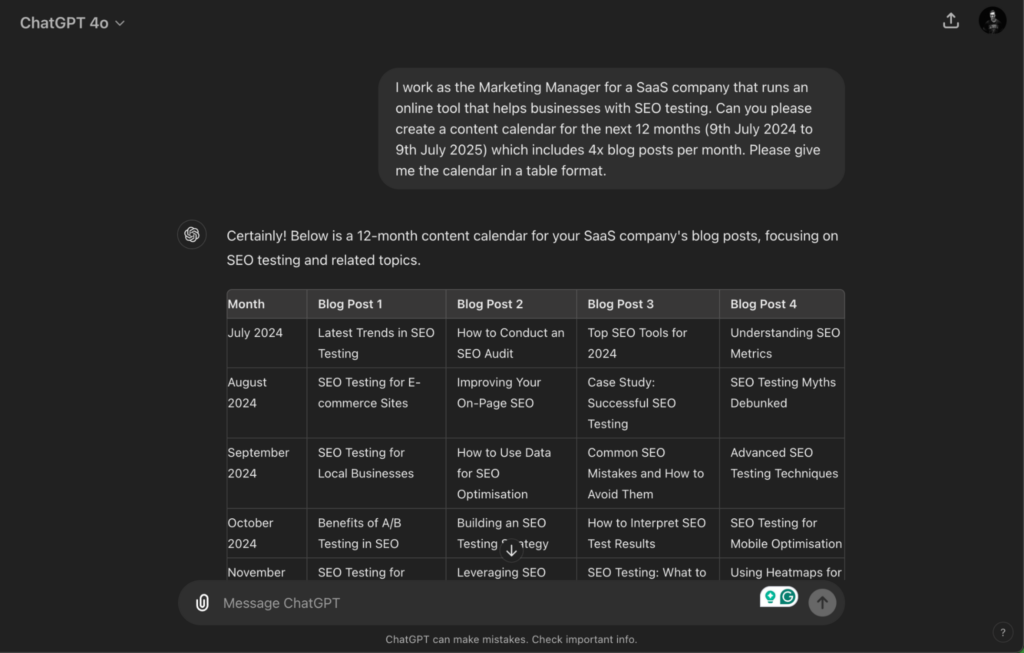
For this example, you can see that I gave it minimal information:
- I worked for a company that builds software to help with SEO testing.
- I wanted ChatGPT to provide me with a full year’s worth of content.
- I wanted it to give me 4x pieces of content per month.
And it has done precisely that.
Of course, you can see the issues with this particular example. It has only given me content on SEO testing and has not given any other supporting pieces. But this is a good starting point.
ChatGPT is excellent when you use it to aid your content calendar creation. Just take the content ideas it gives you with a pinch of salt, or even better, insert your keywords from your own keyword research, and it can help you create great content calendars in just a few minutes.
Topic clusters and pillar content
We have touched on this earlier in the article, but ChatGPT is a brilliant tool for clustering your content. This can come from content you have already written, for example, if you want to run an SEO test on whether some articles can be merged into a piece of pillar content. But it can also come from ideas from new articles.
Let’s take a look at an example:
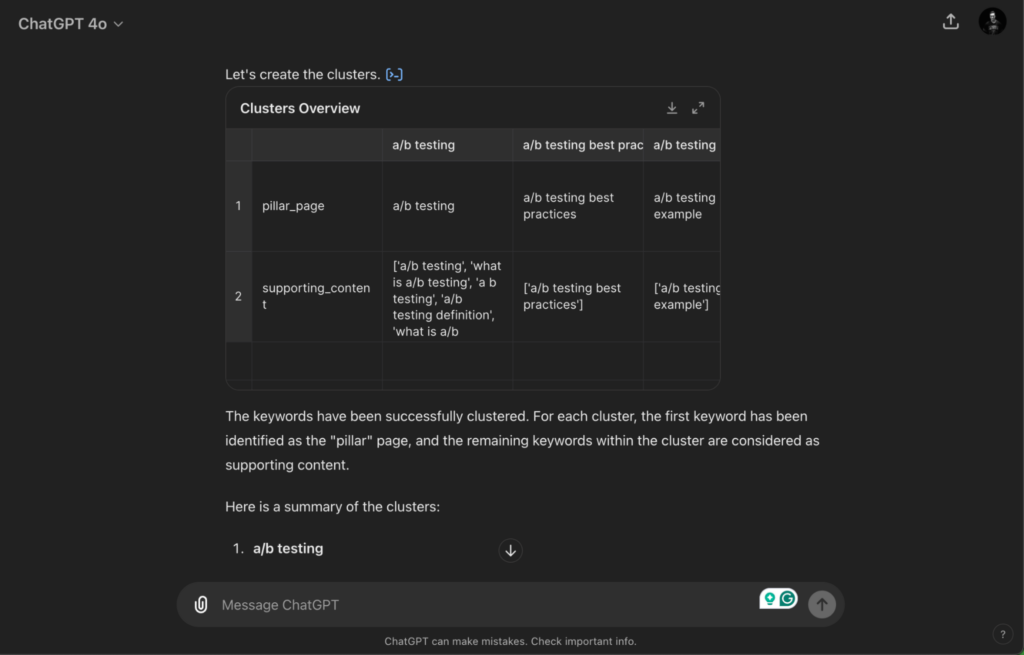
The above shows ChatGPT giving me some ‘hub-and-spoke’ content clusters based on a list of keywords I shared. The exact prompt I used was:
“I am uploading a CSV file with 100 keywords about a/b testing. Please can you cluster this for me? For each cluster, I want the “pillar” page and then the supporting pieces of content.”
I imported a CSV (taken from Google Search Console) with 100 keywords about a/b testing and then asked it to create content clusters for me, including a pillar page and all the necessary support pieces.
Competitor content analysis
ChatGPT is an excellent tool for analyzing competitor content. It usually processes information quickly and accurately and provides insightful summaries.
You can use prompts, such as:
“Analyze the strengths and weaknesses of [URL] from an SEO perspective.”
ChatGPT will give you a detailed breakdown of the content, highlighting key points and areas where that particular piece of content excels or falls short. This will be great when you sit down and plan your content to compete with it in the SERPs.
Let’s take a look at this in action:
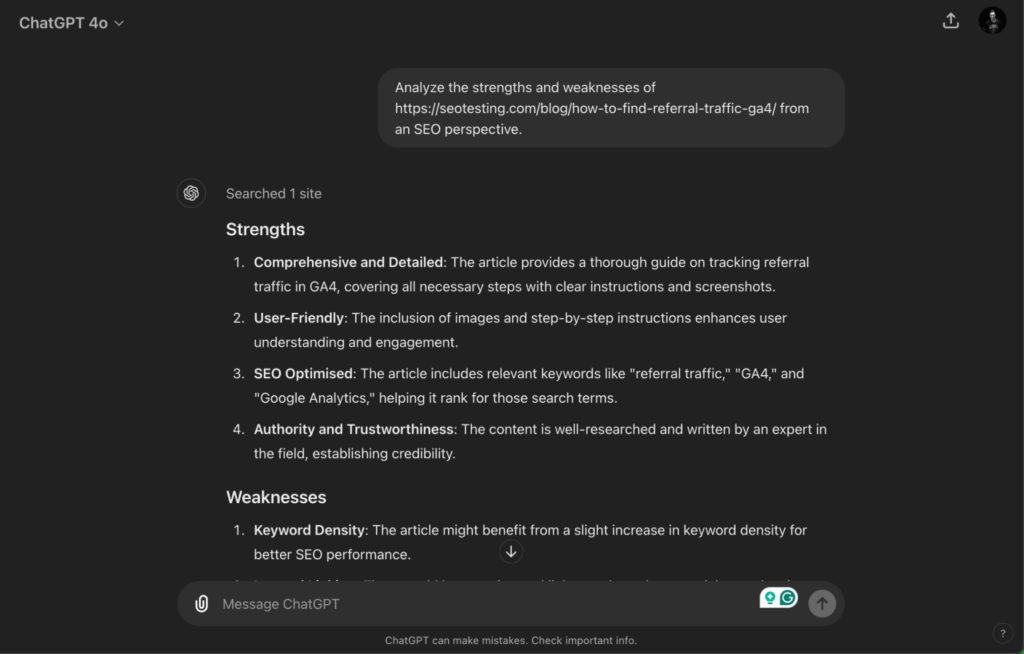
You can see that I used the same prompt I used above to give me an analysis of one of our previous blog posts. It came back with strengths, weaknesses, and a list of recommendations that included:
- Increasing the number of keywords used in the content.
- Improving internal linking.
- Optimizing images.
- Refining the meta title and description.
You can tell that these recommendations are based on the URL provided because you can see it has searched the URL and visited the website. This is indicated by the wording “Searched 1 site” within ChatGPT’s response.
Of course, I don’t need to do this, but it does give me some good ideas of things to do if I find that this page is underperforming.
Technical SEO
ChatGPT isn’t just useful for content-orientated tasks; it is also great at taking on some of the responsibilities of a technical SEO professional, from schema creation to URL optimization and site speed optimization.
Schema creation
I find ChatGPT incredibly useful for schema markup creation. It helps reduce the manual time needed to create structured data snippets while ensuring accuracy.
This helps ensure search engines understand your content better. As a user, I might ask ChatGPT, “How do I create the schema for an event?” It will give me detailed, code-ready answers, saving time and reducing any errors I might make.
Or you can give it the URL of a blog post that does not have schema markup and ask ChatGPT to provide you with all the schema needed:
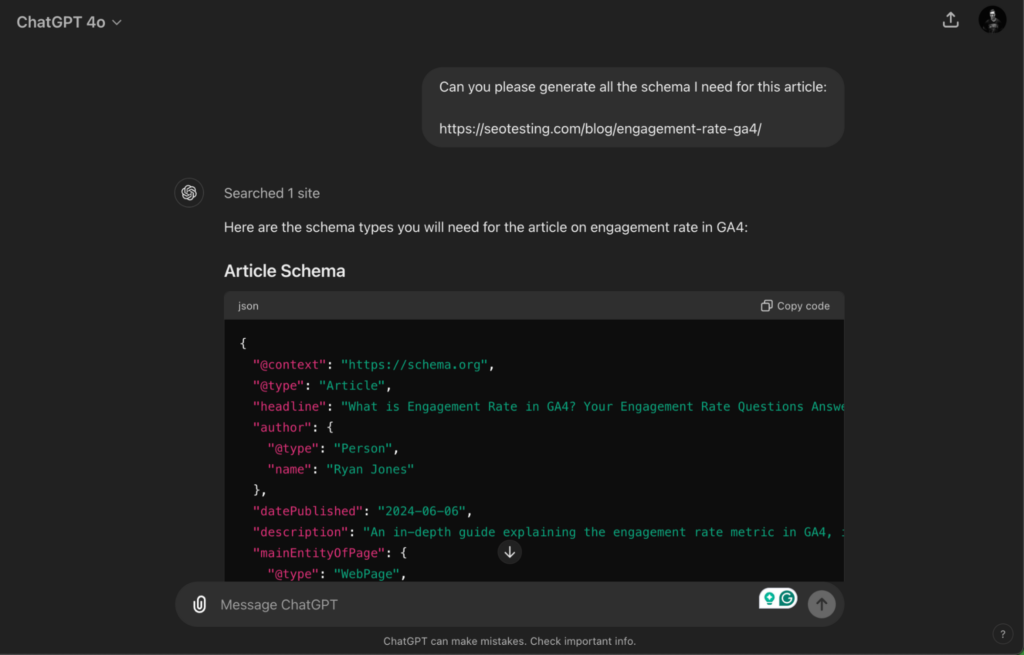
In the above example, I gave it the URL to one of our articles and asked it to provide me with all the schema markup I might need. It analyzed the article and realized we’d need the following schema:
- Article schema
- FAQ schema
- HowTo schema
- Organization schema
It has allowed me to read the article, understand it, and get all the schema I need in code-ready snippets I can copy and paste.
URL optimization
ChatGPT excels in URL optimization by providing tailored advice and actionable insights. Its ability to analyze existing URLs and suggest improvements ensures that your URLs are concise, descriptive, and keyword-rich.
For instance, an SEO professional might prompt ChatGPT with, “Analyze my page’s URL and recommend optimizations for the page I provide: [URL].” This enables the AI to highlight areas for improvement, such as removing unnecessary parameters or reformatting for better readability.
I put the above prompt into ChatGPT, and this is what it came up with:
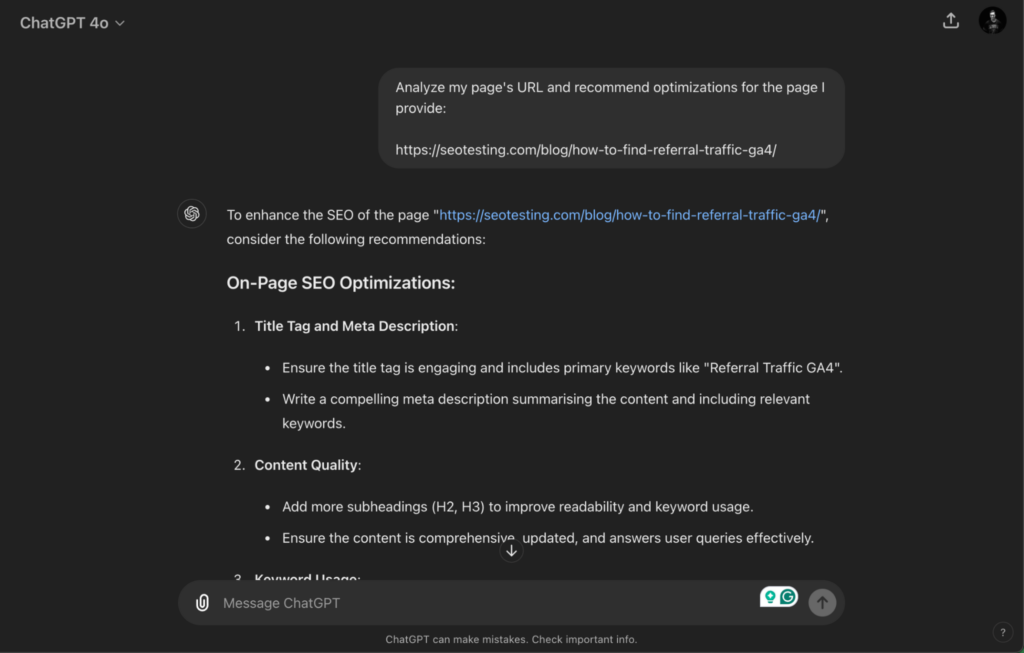
As you can see, it analyzed the URL I provided and came up with a list of potential optimizations:
- Ensuring the title tag features primary keywords.
- Writing a compelling meta description.
- Adding more subheadings to improve readability and keyword usage.
Just remember that ChatGPT still tends to provide canned responses here, but it will still give you some ideas for things you can test.
For bonus points, you can specifically ask it to analyze your URL from a competitor’s point of view:
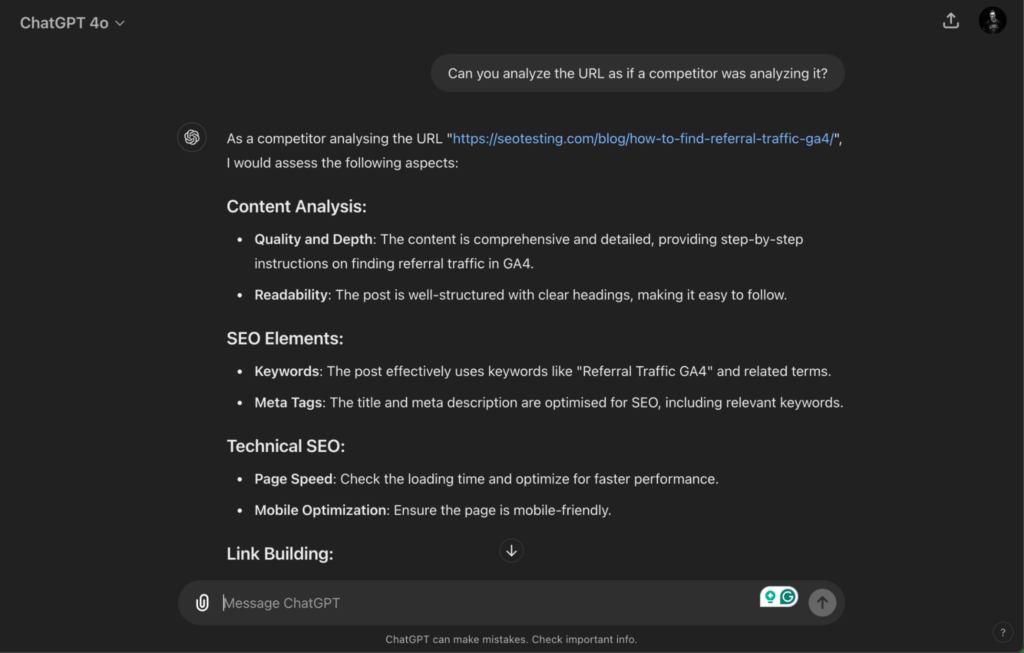
It continues, stating what it is analyzing and telling you what is good or bad about the article.
Site speed optimization
ChatGPT is a valuable tool for site speed optimization. It provides practical advice and step-by-step solutions. Its insights help identify factors slowing down your website and suggest targeted improvements.
For example, you might prompt, “How can I improve my site’s loading time?” ChatGPT would respond with strategies like compressing images, enabling browser caching, and minifying CSS and JavaScript files.
Let’s take a look.
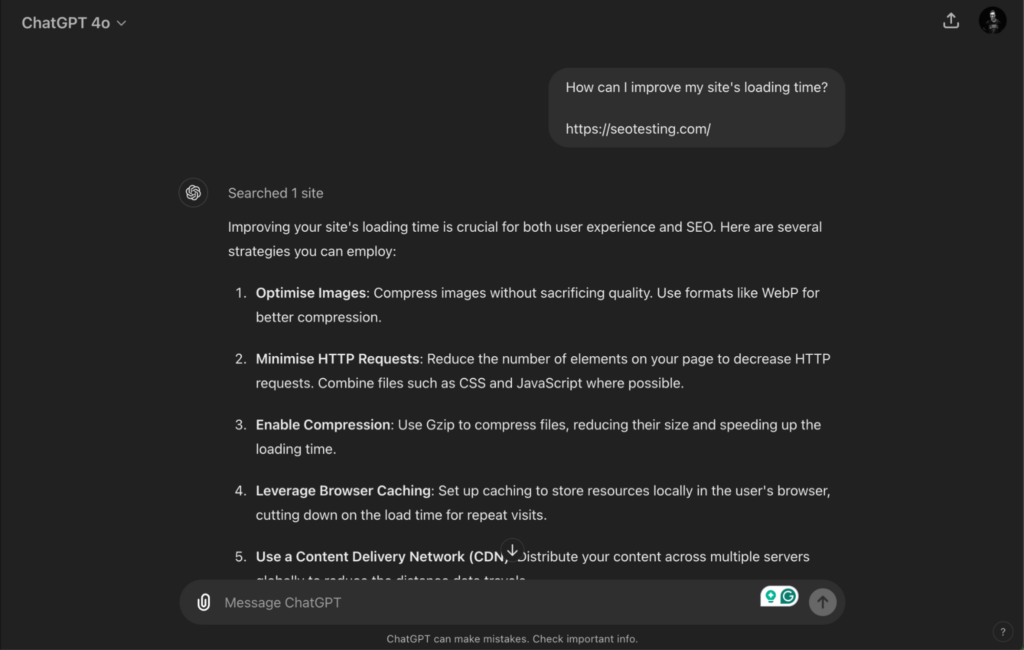
Yes, it did precisely that… Although to give a counter-argument, these responses are also a little ‘canned,’ which we will explain why this is a little later.
But again, it does give you good ideas of what to test when you want to improve your site’s speed.
Link acquisition
Finally, ChatGPT also has some great uses to make the long, laborious task of link acquisition more efficient.
We’ll use this section to talk about how ChatGPT can be used to draft email outreach campaigns, research different prospects, and analyze competitor websites/links.
Outreach email drafting
If we think about traditional link building and acquisition, your routine will probably look something like this:
Find prospects → Find emails → Send emails → Write responses as they come in.
ChatGPT can make the process of writing these emails much more efficient. However, you must ensure your email is engaging, easy to read and understand, and includes all relevant information.
A simple prompt within ChatGPT can create a good starting point:
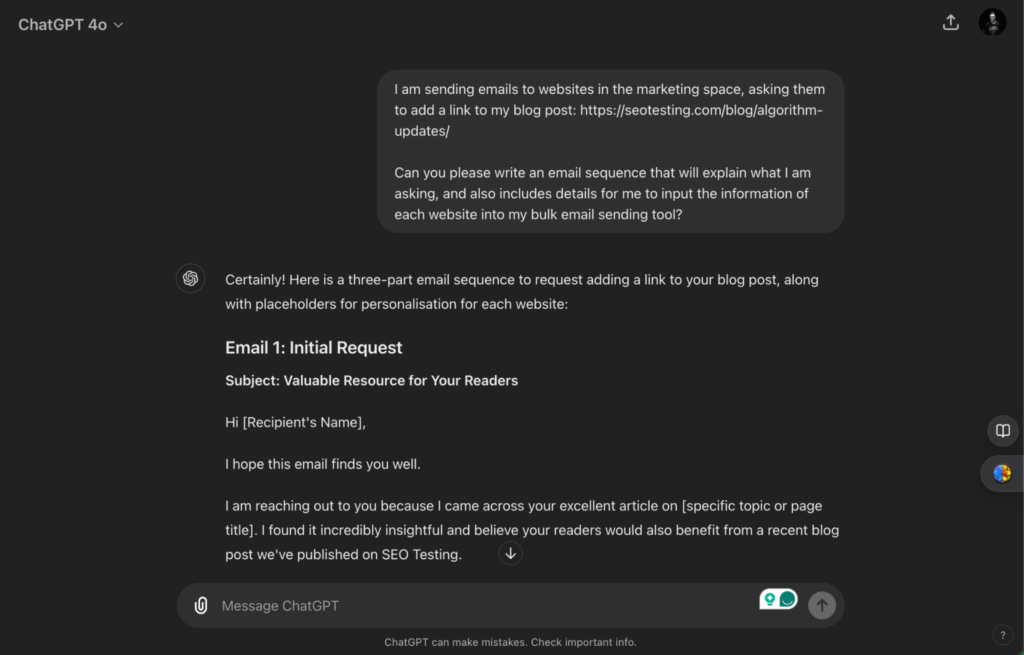
I inserted my prompt, and ChatGPT came back with three emails:
- The first email.
- Follow up number one.
- Follow up number two.
It also included different sections where I could add information to my bulk email sender to use the same email template for my outreach.
Prospect research
If you have written a piece of content, one of the first things you want to try is to build links to that piece to help add some authority to the post.
Let’s see an example:
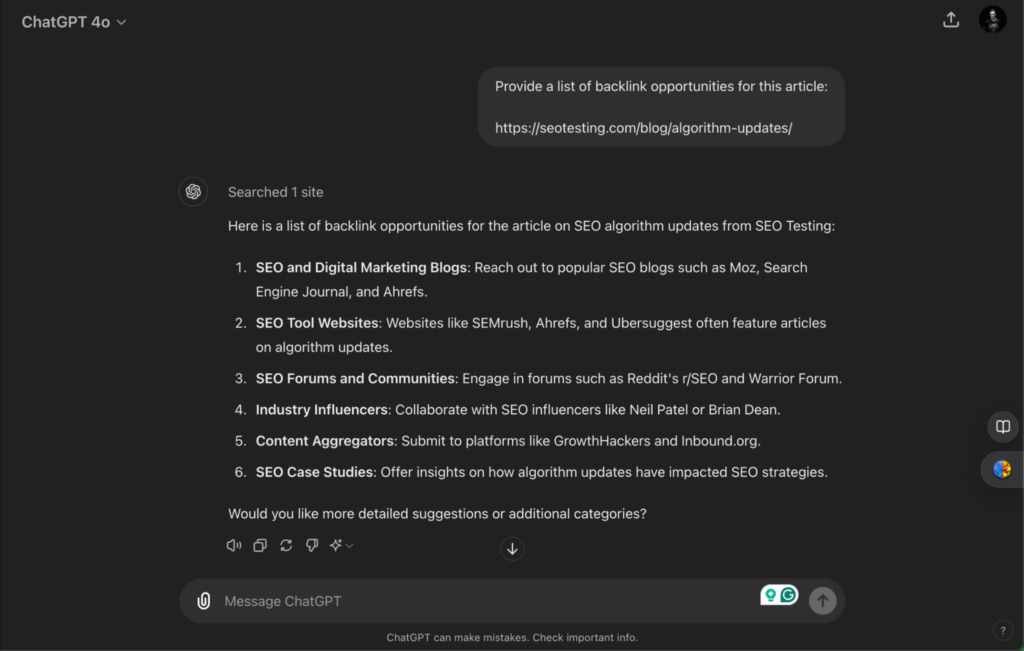
I gave it one of our blog posts for this example and asked it to give me some backlink opportunities. ChatGPT, in return, came back with some good ideas:
- SEO and digital marketing blogs
- SEO tool websites
- SEO forums and communities
- Industry influencers
- Content aggregators
Of course, not all of these will be relevant to the exact blog post. We can debate the usefulness of forum links and links from content aggregators, but the reality is that using ChatGPT to give some quick backlink ideas for content pieces is an excellent tool.
Competitor analysis
An underrated use of ChatGPT is its ability to analyze competitor content from a link perspective.
Let’s say, for example, that I am writing a piece of content and want it to compete with a competitor’s article on the SERPs. I could give ChatGPT a list of my competitor’s backlinks on their content, ask it to take these into account and give me some backlink ideas:
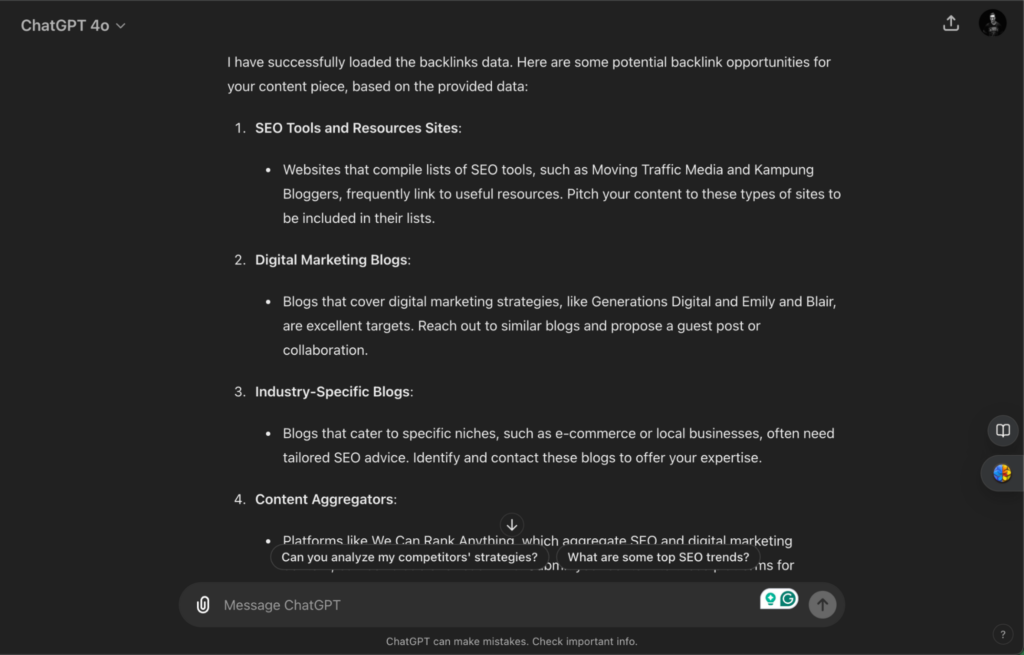
Using this prompt:
“I am uploading a CSV file which contains backlinks to a competitor’s piece of content.
Taking these backlinks into account, can you give me some backlink opportunities for the content piece that I am writing?”
I could upload a CSV with a page’s backlinks to ChatGPT, which would allow it to analyze those URLs specifically and provide me with relevant backlink opportunities.
What are ChatGPT’s SEO limitations?
This article shows you how to use ChatGPT for many SEO-based tasks, but we must balance it. ChatGPT does, indeed, have some limitations that you need to consider when using it for your work.
Lack of unique content
The first and most crucial point is that ChatGPT tends to produce content that is not unique. While it can produce high-quality content, it is a tool that still lacks the human input to make the content great.
This all goes back to how ChatGPT works, using next-token prediction. At the minute, all ChatGPT can do is use the phrasing you have used in your prompts to predict the desired outcome, and then it uses its large language model to give you a response. In all cases, this response comprises what ChatGPT can take from other sources on the web and put together in a reaction.
It’s also worth noting that ChatGPT tends to produce content that overuses compound-complex sentences and adjectives, which can make AI-based content very easy to spot.
Inaccurate content
We also need to point out that ChatGPT can produce inaccurate content.
Firstly, it trusts the information provided by the user within the prompt. So, if I told it to write a post about the best SEO testing tools but also mentioned that SEOTesting is the best tool ever created for SEO testing, it would consider that within the response.
ChatGPT also lacks access to recent news, which limits its ability to provide up-to-date information. We’ll discuss this in the next section, but it’s important to remember to check the stats provided by ChatGPT, as these could be inaccurate.
ChatGPT also doesn’t ‘like’ searching deeply for new information; instead, it relies on the data it already has. This can result in ‘hallucinations’ within ChatGPT’s responses, where it generates content that seems plausible but is incorrect.
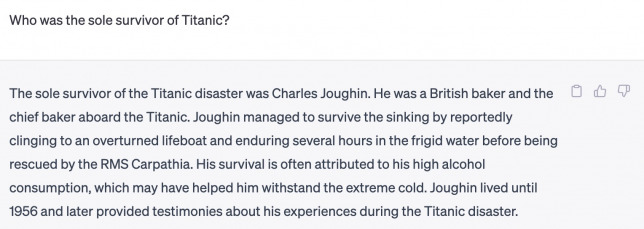
Like telling you that the sole survivor of the Titanic disaster was Charles Joughin… In reality, 705 people survived it.
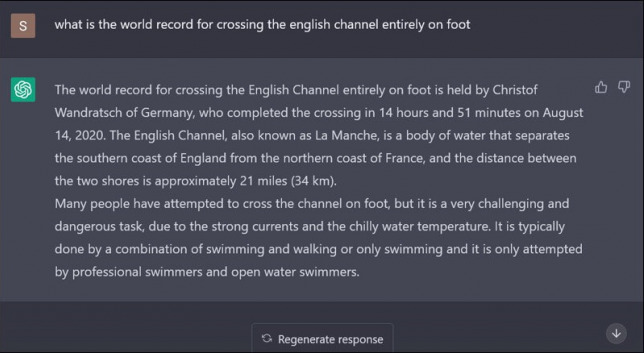
Or telling me someone crossed the English Channel on foot in under 15 hours…
It is important to note that, as ChatGPT has evolved and more training data has become available, these hallucinations have become much less common. But they still happen. So, if you are using it to write content, make sure you are fact-checking.
Here’s one thing to remember…
ChatGPT (specifically GPT-4) is correct 96.3% of the time, which is excellent. But that means that it still gets it wrong 3.7% of the time, so if you are using ChatGPT a lot, it will happen that it will give you incorrect information.
Outdated information
ChatGPT often provides outdated information primarily because it lacks access to recent news and real-time data. This limitation arises because the model is trained on a dataset that only includes information up to a specific cutoff date, beyond which it cannot update itself or fetch new information independently. As a result, any developments, discoveries, or events that occur after this cutoff date are not reflected in its responses.
This is particularly important to remember when dealing with rapidly changing fields such as technology, medicine, finance, and current events. For instance, if there have been significant advancements in medical treatments or changes in economic conditions, ChatGPT would be unaware of these updates, leading to potentially outdated or incorrect advice.
ChatGPT can request a URL as part of a prompt, as shown in some of our above examples, but it will not actively search the internet (unless you specifically ask it to) when generating a normal response.
Instead, unless told otherwise, it relies on the static data it was trained on, which can lead to it spitting out obsolete facts and figures. This limitation makes it crucial for users to verify any statistical or factual information provided by ChatGPT against current and authoritative sources to ensure accuracy.
Usage limits
This hasn’t been discussed enough, but ChatGPT also has usage limits that you should consider.
For free users, the latest model version, GPT-4o, has a limit of around 16 messages per three hours. Once this limit is reached, users are switched to GPT-3.5 to continue their conversations.
The limits for ChatGPT Plus users are more generous. They can send up to 40 messages per three hours with GPT-4 and around 80 messages per three hours with GPT-4o.
Best ChatGPT browser extensions for SEO
With ChatGPT’s recent growth, we also have to talk about some browser extensions that have entered the market that utilize ChatGPT to make some SEO-based tasks more efficient. In this section, we’ll discuss:
- WebChatGPT
- ChatGPT for Google
- YouTube Summary with ChatGPT & Claude
- Merlin
- ChatGPT Prompt Genius
WebChatGPT
WebChatGPT enhances ChatGPT by integrating it with real-time web browsing capabilities, allowing users to fetch up-to-date information directly within their ChatGPT interface.

For SEO professionals, this means accessing the latest search trends, competitor analysis, and industry news without leaving the chat interface. It streamlines data collection for keyword research, backlink strategies, and content optimization, saving time by reducing the need to switch between multiple tabs and tools.
ChatGPT for Google
ChatGPT for Google integrates AI-generated responses directly into Google search results, providing valuable insights alongside traditional search engine results.
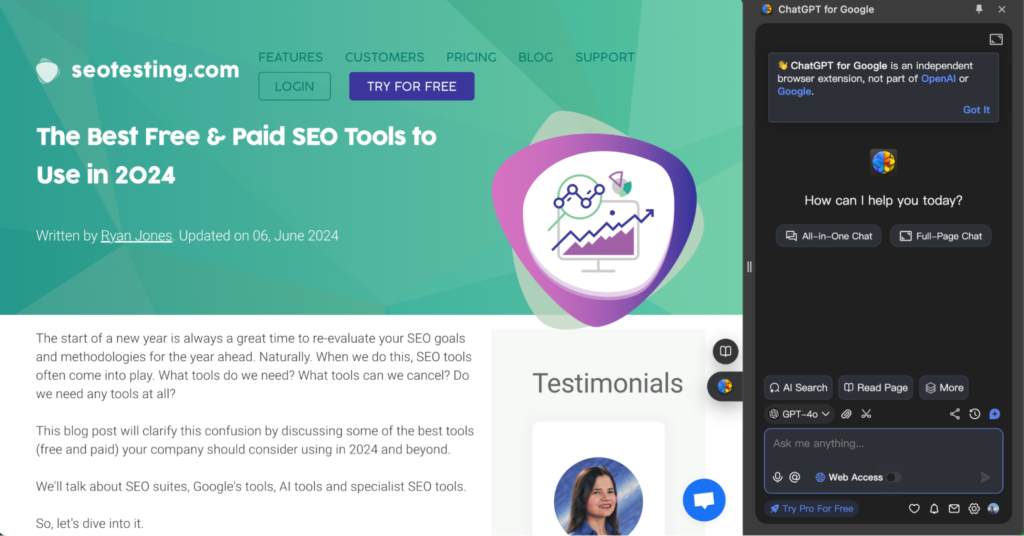
This tool lets you quickly compare AI-generated content with actual SERPs to understand current ranking factors. It also helps generate new content ideas, find inspiration based on AI’s interpretation of search queries, and quickly identify gaps in competitor content and SEO strategies.
YouTube Summary with ChatGPT and Claude
YouTube Summary with ChatGPT & Claude provides concise summaries of YouTube videos, allowing users to quickly grasp content without watching the entire video.
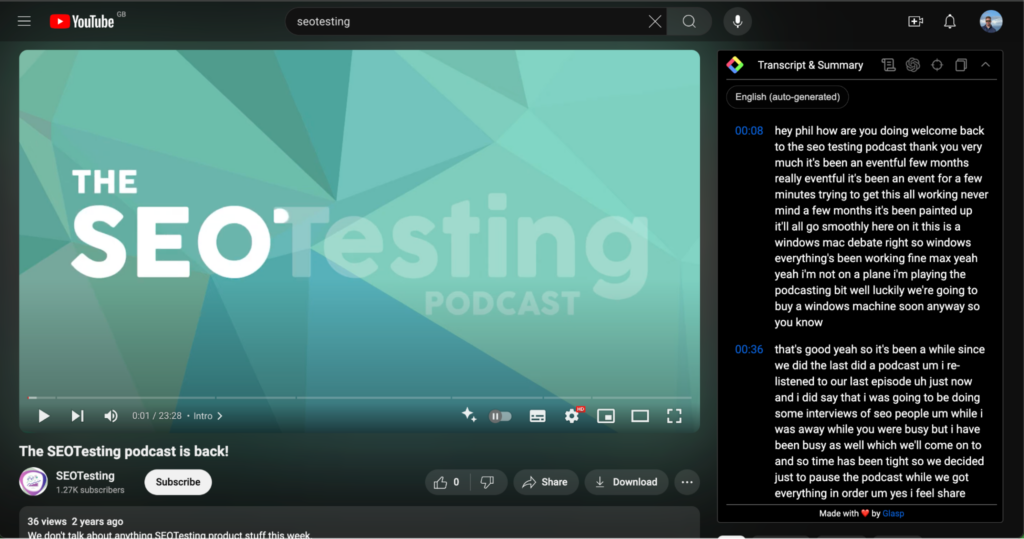
This tool is fantastic for extracting key points and themes from popular videos. These can be repurposed into blog posts, social media content, and other digital materials. So, if you’re a marketing manager, you can quickly take your video content and repurpose it into many different formats!
Create once, distribute forever. If you’re a Ross Simmonds fan, you will understand that reference!
Merlin
Merlin is an AI assistant that integrates with various websites to provide contextually relevant information and assistance.
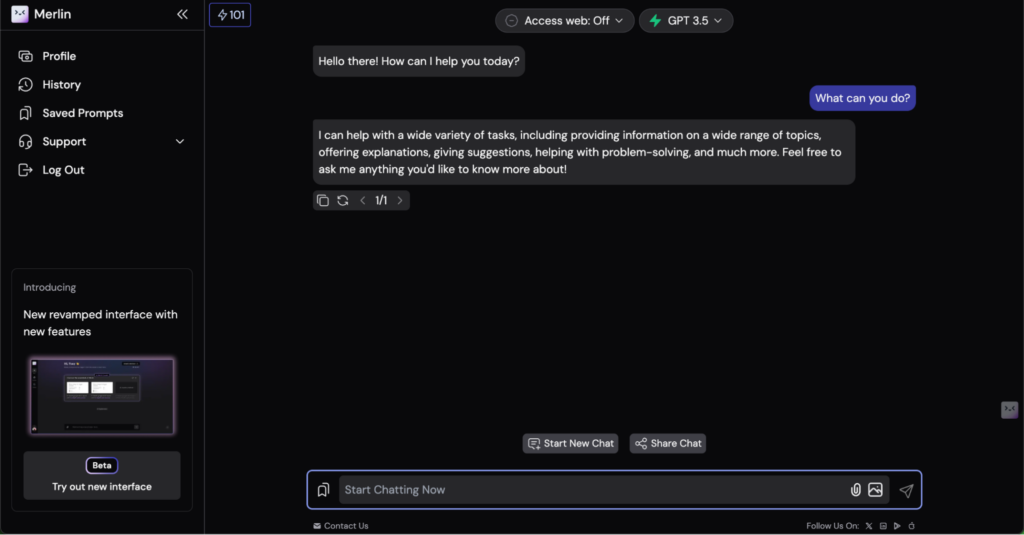
If you work in SEO, which you probably are if you’re reading this article, Merlin offers on-the-spot recommendations and insights while working on web pages, your website’s CMS, or SEO tools. It automates repetitive tasks such as data gathering and initial analysis, allowing for better time management.
ChatGPT Prompt Genius
ChatGPT Prompt Genius helps users generate creative and effective prompts for ChatGPT, optimizing their interaction with the AI to achieve desired outcomes.
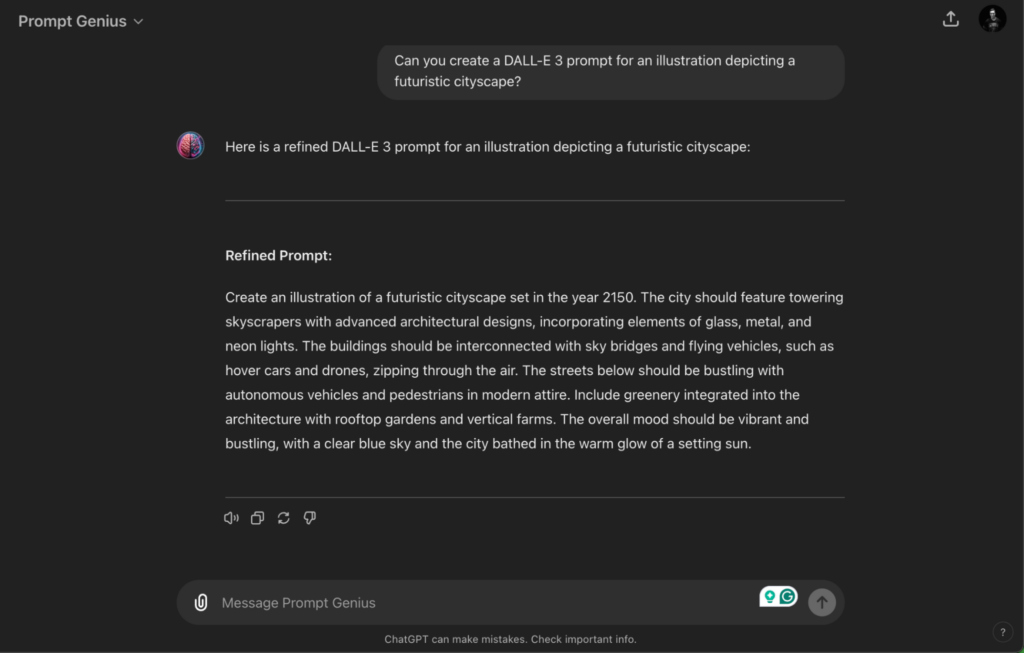
The key to getting the most out of ChatGPT is getting your prompts right, and ChatGPT Prompt Genius can help with this, especially if you’re looking to brainstorm new content ideas to optimize your keyword strategies and marketing campaigns.
How has ChatGPT impacted the SEO industry?
Having spent nearly a decade in SEO, I’ve seen plenty of dramatic shifts. From the days when you could still get good results by manually stuffing keywords into your content—not that anybody ever did this, of course—to the sophisticated algorithms used today and the testing work we need to do to find what works.
ChatGPT represents another pivotal transformation. It excels at producing high-quality content quickly, aiding content marketers. Given its ability to analyze vast amounts of data to uncover insights and predict user behavior, it can also help more data-driven marketers.
However, overreliance on AI and ChatGPT as one of the main tools can lead to a lack of originality in your marketing. Maintaining a good level of human oversight for quality control is also crucial.
Frequently asked questions
To round off this article, we wanted to answer some questions that are being asked regularly around ChatGPT and SEO. Below, you will find answers to some of the web’s most searched questions on this topic.
Does Google penalize ChatGPT use?
Luckily, this is a relatively easy one to answer.
No. Google does not explicitly penalize ChatGPT or any other AI tool-generated content. Google and its algorithms choose to focus on content quality, relevance, and the experience users are having on your website.
Think E-E-A-T.
If AI-generated content meets these standards, it can still perform well in the SERPs. However, low-quality, spammy, or duplicated content may be penalized regardless of its source (human or AI).
So, if you use AI-generated content, ensure it’s well-crafted, original, and valuable to users. Do that, and you can’t go wrong.
Is ChatGPT bad for SEO?
I hate to use an “it depends” answer here, but that is the case.
The use of ChatGPT can impact SEO both positively and negatively, depending on how it’s used. On the plus side, it can help you create high-quality content, improve user engagement, and keep website publishing fresh content. However… If not properly supervised and edited, it’s guilty of creating generic content or duplicating content already on the web, which can harm your SEO.
To leverage ChatGPT effectively, always review what it generates, don’t publish 100% AI content, and monitor SEO performance in the areas where ChatGPT is being used.
Is AI replacing SEO?
No. AI is not replacing SEO. It is transforming and enhancing it.
Well, when done right, anyway.
AI tools like ChatGPT assist in content creation and keyword analysis and provide data-driven insights, making SEO efforts more efficient and effective. However, human expertise remains crucial for strategic planning, understanding nuanced search intent, and creating authentic, engaging content. AI helps you with these activities but does not replace the need for skilled SEO professionals.
What is the best use of AI in SEO?
I’ve been involved in SEO for nearly a decade, so I’ve seen AI come into marketing and SEO at every stage.
The best use of AI in SEO involves enhancing (not replacing) various processes to improve efficiency and effectiveness. It can help you create content quicker, optimize it to target your chosen queries better, and quickly analyze thousands of data points.
How much does ChatGPT cost?
ChatGPT offers several pricing plans.
- The Free plan includes access to GPT-3.5 with limited features at no cost.
- The Plus plan costs $20 per month and provides faster responses and access to GPT-4, including data analysis, file uploads, vision, and DALL·E image generation.
- The Team plan costs $25 per user per month (billed annually) and includes higher usage limits and additional administrative tools.
- The Enterprise plan offers extensive features and customization options for large businesses, but you must contact OpenAI’s sales team for exact pricing.
Let’s wrap things up
ChatGPT emerges as a powerful ally rather than a replacement.
By leveraging its capabilities, you can enhance your keyword research, streamline content creation, and optimize various technical aspects of SEO.
However, it’s vital to maintain a balance between AI-driven efficiency and human creativity to ensure the content remains unique, accurate, and engaging.
ChatGPT can significantly ease the workload but requires careful supervision and a strategic approach to maximize its potential. Embrace this technology wisely, and it will undoubtedly become an invaluable asset in your SEO toolkit, helping you stay ahead.
Ready to supercharge your SEO efforts? With SEOTesting’s ChatGPT integration, writing great meta titles and descriptions has always been challenging. Try SEOTesting today and take advantage of our 14-day free trial—no credit card required. Start optimizing your SEO strategy now and see the difference intelligent automation can make!


